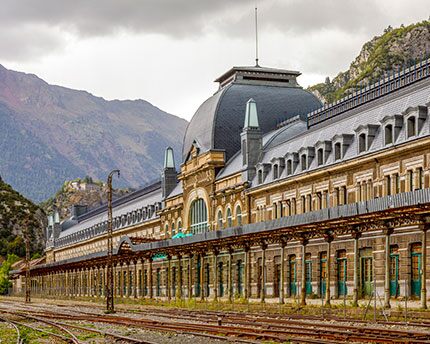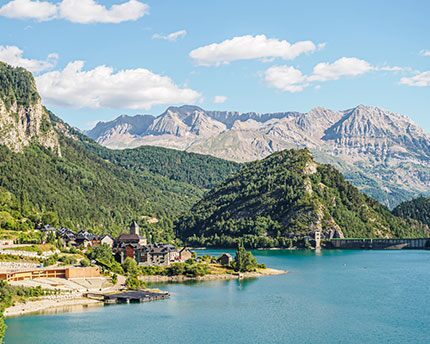Canfranc, the most beautiful train station in Spain
Canfranc is perhaps the most beautiful train station in Spain. It is an impressive building, surrounded by mountains, on a esplanade bordering France. It has a legacy by way of the stories and voices which remained silent for decades. Next stop: Canfranc.
Train stations are very often the best witnesses to history. They have seen magnificent moments, sad departures, joy and farewells, trains loaded with goods and people right at the border of two countries which have sometimes been united and other times at loggerheads.
The Canfranc station embodies all of this. It is a building which speaks for itself, due to its size. When you look at it, it has an aura of mystery in tandem with the legend. If you are touring the Pyrenees of Huesca or if you are visiting Jaca, don´t miss Canfranc.
- Historia de la estación de Canfranc
- Visitas a la estación de Canfranc
- Qué ver en Canfranc pueblo
- Qué comer y dónde comer en Canfranc
History of the Canfranc station
The international station of Canfranc is closely related to the rail link between Spain and France. The Somport border tunnel linked the two countries of the Pyrenees. This brought new possibilities for moving passengers and goods.
The idea behind this project first arose in 1853, in a call for the construction of a line from Madrid-Paris via the Aragonese Pyrenees. Eleven years afterwards, the first studies began. It was recommended that the line should pass through Saragossa and the French town of Pau.
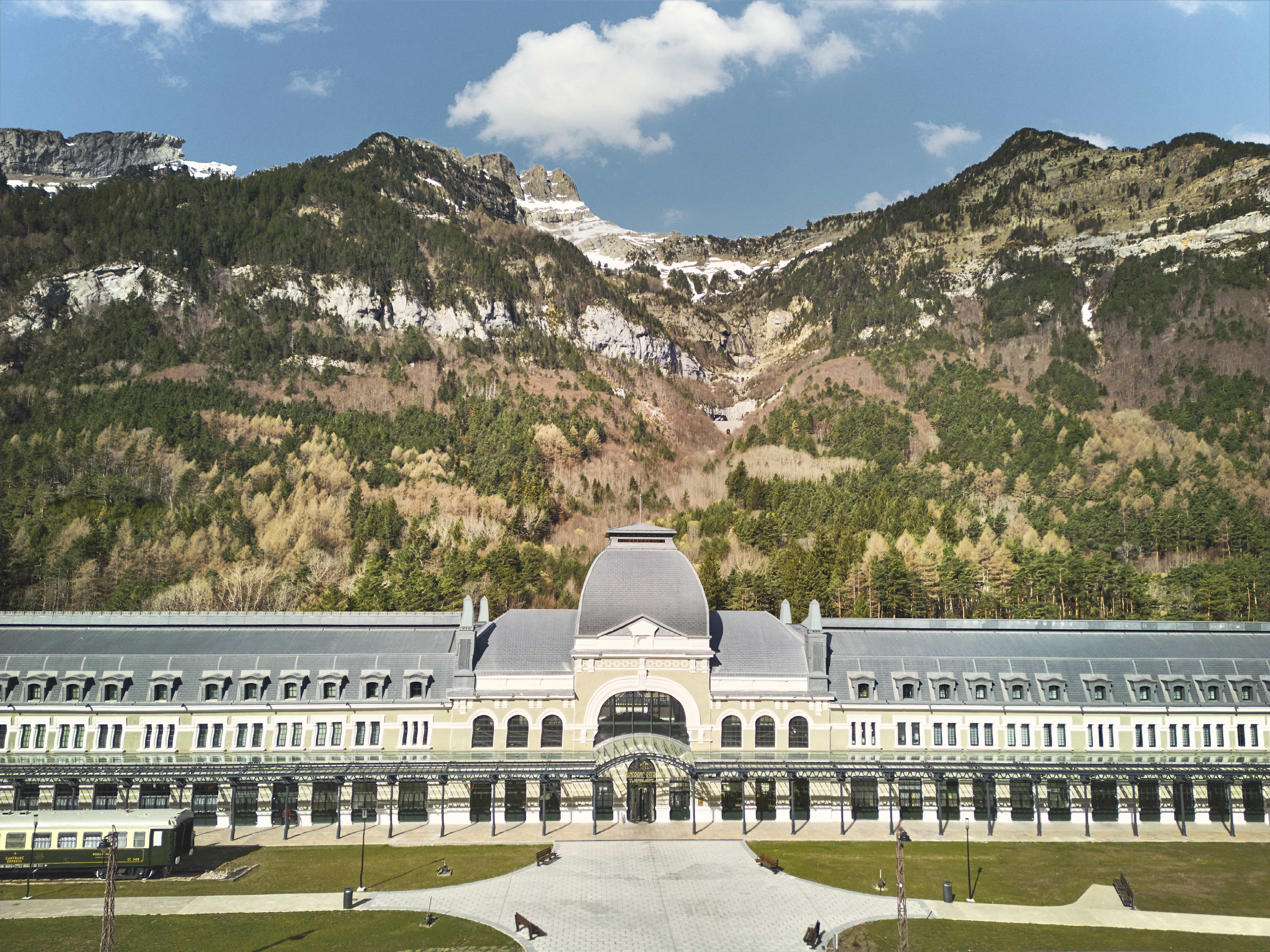


Huesca
Canfranc Estación, a Royal Hideaway Hotel
Works on the Somport tunnel (a crucial section of the project) were carried out between 1908 and 1912. However, it was not until 1928 when Canfranc station was inaugurated, with the king Alfonso XIII and the French president Gaston Doumergue presiding.
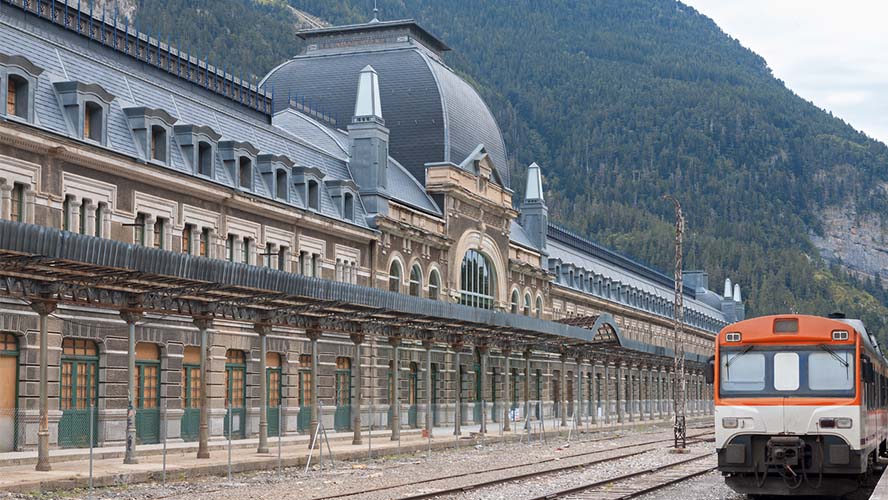

Train passing through the Canfranc Station
Nazi gold in exchange for Galician wolfram in Canfranc
In the Spanish Civil War, the nationalists closed the Somport tunnel to prevent any raids from France. However, some of the best stories about the station happened during the Second World War.
As the French side was controlled by the Nazi army, in Canfranc there were trains used to carry Galician wolfram to the tank factories in Germany. Franco repaid the help Hitler gave him during the Spanish Civil War. In the inverse situation, trains laden with gold entered Spain originating from Germany. Most Nazi gold would keep moving until reaching Portugal. The customs at Canfranc was under the control of the SS and the Gestapo.
After the war, the Canfranc station would never regain its former glory. Activity at what was then the second largest station in Europe would decline and grind to a halt. This occurred with the end of the international link between Spain and France at Canfranc, caused by the collapse of the L’Estanguet bridge in 1970 on the French side in suspicious circumstances.
An international station
The main feature of the Canfranc station is its international nature. As tracks in Spain have a different gauge (the Iberian gauge is1668 millimetres as opposed to 1435 for the European gauge), this meant there had to be two marshalling yards, one for each side of the building, with their respective duplicated platforms, entrances, and internal services for the station.
Both the passengers and the goods had to change from one side to the other if they wished to continue their journey between both countries. However, the building also provided the same services on both sides in order to service each country. There were ticket boxes, exchange bureaus, customs, police stations, post offices and hotels… amongst other services.
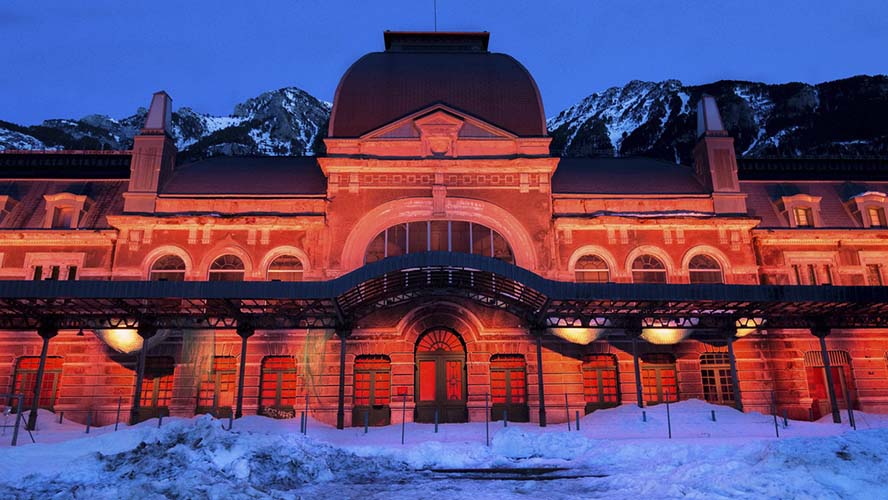

Canfranc Station illuminated
This explains the impressive size of the Canfranc station: 241 metres long, 12 metres wide, 365 windows (one for every day in the year), with 75 doors on either side. The longwise view of this enormous building is impressive, an authentic rail border on Spanish soil.
On first sight, the Canfranc station is reminiscent of the style so frequently used in French stations. This can also be seen in buildings such as the current Museé d´Orsay (The Orsay Museum) in Paris with a slate roof, dormer windows, art-deco pinnacles and a large central dome. The building is long and narrow to provide space for the two marshalling yards that must be accommodated on both sides.
Visits to the Canfranc station
Despite being abandoned for decades, the Canfranc station has always been a great attraction for tourists and railway enthusiasts. On being restored for future hotel projects, the area has been revitalised. This has raised interest in finding out about the past behind this magical building.
Guided tours of the station
The Canfranc Council organises guided tours of the train station. Given the limited capacity and the high demand for tours, tickets must be booked through the Council website. It is not possible to visit the building on your own.
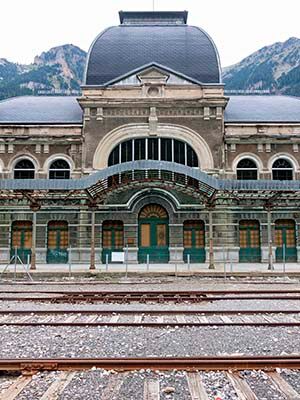

The spectacular entrance of the Canfranc Station
The guided tour of the Canfranc station lasts around 40 minutes and are given both in Spanish and French. After explaining the history of the station, the tour goes from the concourse to the underpass.
What to see in the town of Canfranc
The project for linking a railway between Spain and France through Somport went in tandem with the construction of a new settlement centred on the future station of Canfranc in Los Arañones. This is what is known today as Canfranc-Station, which is four kilometres north of the original town of Canfranc.
So, here there are homes, hotels and other types of buildings surrounding the old station today and which are part of the industrial activity linked to the border crossing.
Apart from giving an insight into the special nature of railway life, Canfranc and Canfranc town harbour some interesting elements of historical heritage. These are partly linked to the strategic position it has had throughout history. For example, there is the beautiful Fusilier Armoured Lookout Tower (nineteenth century) which may have contained a contingent of 25 men who guarded access to the Aragon Valley.
Also, there are the different bunkers related to the Second World War, whose aim was to guard against a possible invasion from France. These military constructions may be toured by following the so-called Bunkers Trail.
However, without doubt, Canfranc is the entrance point to one of the most popular skiing spots in the Pyrenees. Here, there are the ski stations of Astún and Candanchú (internal link) located a few kilometres away. Many skiers settle in Canfranc to go up to these two ski centres, each of which have 50 kilometres of slopes.
Moreover, France is on the other side. With the old railway tunnel closed, the modern tunnel of Somport provides a swift, dynamic road connection with neighbouring France.
Te contamos ahora lo que tienes que visitar y no te puedes perder en Canfranc pueblo:
Paseo por el centro histórico
Vale la pena recorrer con calma el corazón del pueblo de Canfranc. Está situado en el Camino de Santiago y nació en el XI en un valle con pocos recursos agrícolas, lo que obligó a sus habitantes a dedicarse al comercio y a la acogida de peregrinos y viajeros. No dejes de visitar los restos de la iglesia de la Trinidad, del siglo XVI; la casa-torre del infanzón Aznar Palacín, del siglo XIV; la iglesia de la Asunción, situada junto al cauce del río Aragón; el puente de los peregrinos, construido en piedra en el siglo XVI, y lo que queda del castillo.
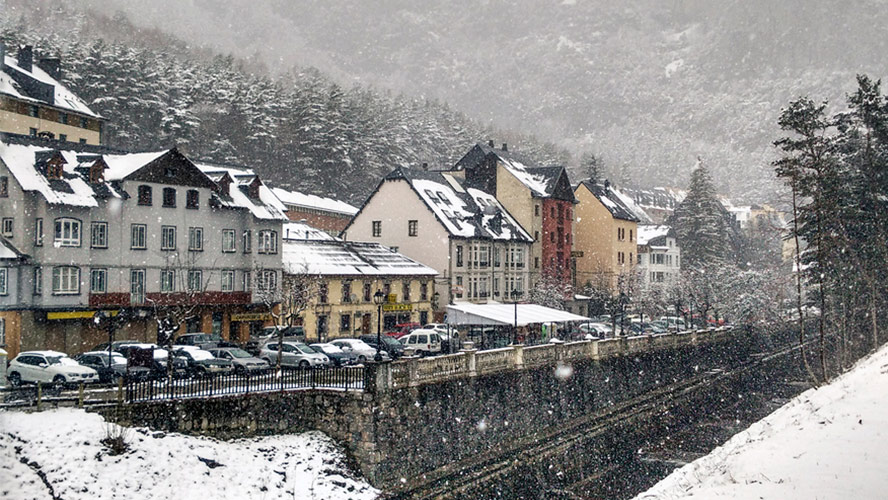

Canfranc
Ruta de los búnkeres
Este curioso e interesante itinerario recorre una serie de búnkeres cuya construcción tenía como objetivo defender la población de una posible invasión militar procedente de Francia que nunca se produjo. Son construcciones militares levantadas entre los años 1944 y 1959. En ese tiempo, se edificaron cientos de búnkeres en toda la zona de los Pirineos, desde el Cantábrico hasta el Mediterráneo. Hay quien dice que hay en total 4.000 asentamientos fortificados. Conocida como “Línea P” ó “Línea Pirineos”, se trata, posiblemente, de la mayor obra de fortificación construida en Europa después de la Segunda Guerra Mundial.
Torreta de Fusileros
Construida en 1876, esta curiosa fortificación see realizó después de terminarse la carretera que une Zaragoza con Francia por el Somport. Se trataba de defender esta importante vía de comunicación con una gran torreta de fusileros que podía albergar hasta un contingente de 25 hombres. La edificación estaba dotada con un cuarto para el oficial, otro para la enfermería, calabozo y leñera. La Torreta de Fusileros tiene una curiosa planta en forma de elipse, un foso perimetral que se salvaba mediante un puente levadizo, y cuatro plantas en torno a un gran patio central.
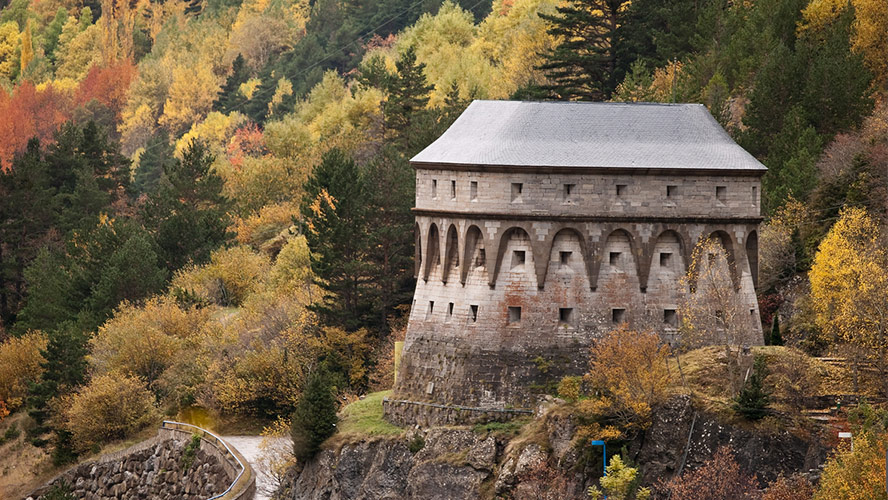

Torreta de Fusileros
Qué comer y dónde comer en Canfranc
La gastronomía típica de Canfranc está basada en productos naturales que son la base de sus excelentes recetas tradicionales. Son célebres sus carnes y sus productos de caza, además de los vinos del Somontano. Si tienes ocasión, prueba los espárrragos montañeses, la empanada goguera, las chiretas, el empanadico o los boliches de Embún. Y de postre, la torta de Ayerbe o el coc de Fraga. Hay muchos restaurantes, y buenos, en Canfranc. Aquí te sugerimos sólo algunos:
Laduanilla Canfranc. Con una decoración tradicional y muy cuidada, estamos ante un restaurante pequeño pero muy acogedor que, cuando hace buen tiempo, cuenta con una bonita terraza. No te pierdas las croquetas de setas, la ensalada con huevo frito y el revuelto de boletus
Borda l’Anglassé. Su carta tiene numerosos platos de la cocina típica aragonesa. Hay para todos: tapas, a la brasa, comida creativa, vegana, para celíacos, a la carta, menú…Todo está a la vista y seguro que tendrás dudas a la hora de elegir. Todo tiene un aspecto muy tentador. Puedes elegir desde una carrillera de cerdo ibérico a baja temperatura hasta una hamburguesa de mijo con crema de queso cheddar y cebolla caramelizada.
La Brasa Asador. En este restaurante la especialidad es la carne, pero tiene muchas otras opciones y todas, caseras. La relación calidad-precio es muy interesante. Tiene, además, un menú diario en el que podrás elegir el plato de tu gusto. Aquí las raciones son generosas y todo está bueno: los calamares, las judías verdes con patatas, las bravas… Es mejor reservar.



Huesca
Canfranc Estación, a Royal Hideaway Hotel
Frequently Asked Questions
¿Dónde se encuentra la estación de Canfranc?
La estación se sitúa en las inmediaciones de la localidad de Canfranc, en la provincia de Huesca, muy cerca de la frontera con Francia.
¿Se puede visitar la estación de Canfranc?
El Ayuntamiento de Canfranc organiza visitas guiadas a la estación de tren. Dada la limitación del aforo y la alta demanda, las entradas se deben reservar a través de la página web del Ayuntamiento. No es posible visitar el edificio por libre.
¿Dónde se pueden conseguir las entradas para visitar la estación de Canfranc?
Se puede reservar por teléfono (974 373 141) o bien online hasta 2 horas antes de la hora programada en www.canfranc.es. Consulta tarifas actualizadas en web oficial. Existen descuentos para niños de 6 a 10 años. Menores de 6 años, gratis.
¿Qué se puede ver cerca de la estación de Canfranc?
En la localidad de Canfranc, además de la estación, debes visitar sin dudarlo la torreta de los Fusileros y los bunkeres de la Segunda Guerra Mundial. También, disfrutar de la naturaleza con las diferentes rutas de senderismo de la zona.
Related plans
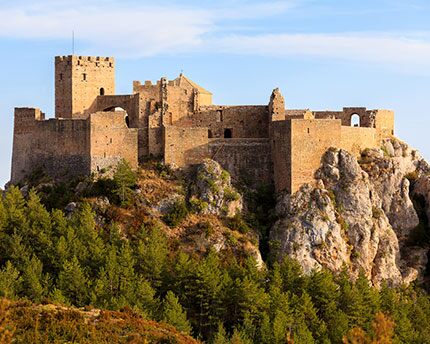
Loarre Castle: the best preserved Roman fortress
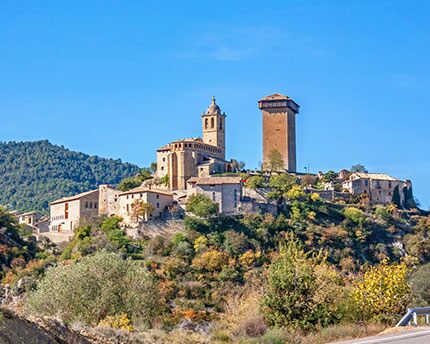
Shrine of Torreciudad: an Aragonese pilgrimage site



